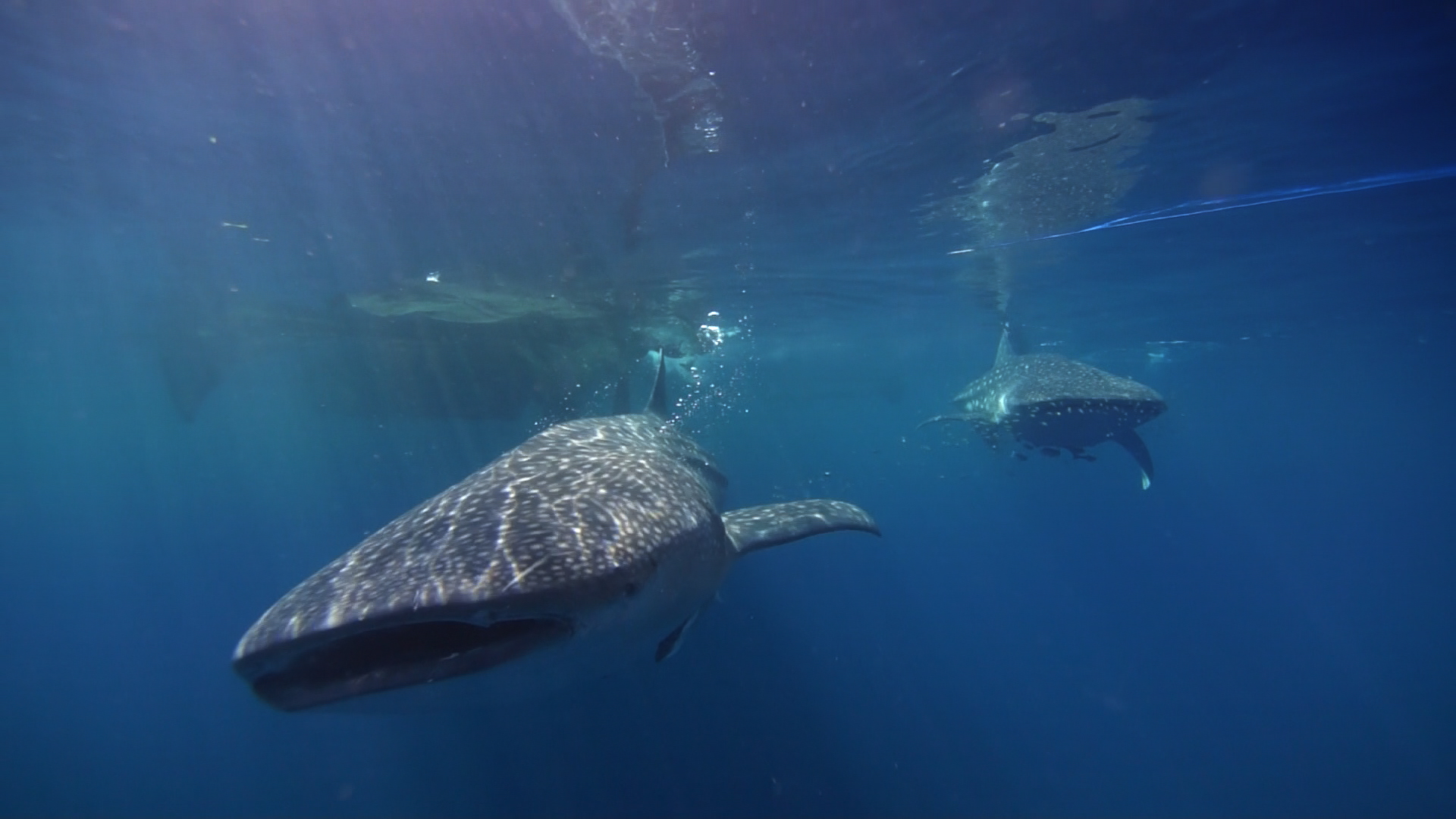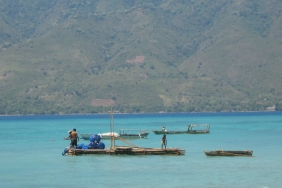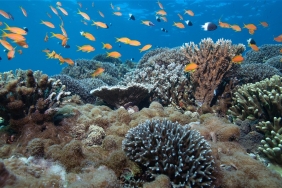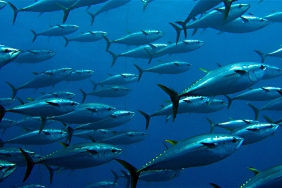TALISAYAN VISITOR WHALE SHARK POPULATION INCREASES
Source: Pontianak Coastal and Marine Resources Management Center (BPSPL)
Pontianak Coastal and Marine Resources Management Center (BPSPL) conducted another Whale Shark (Rhincodon typus) Population Survey and Monitoring in Talisayan Waters, Berau Regency, East Kalimantan on August 19 to 25, 2015. The 2nd survey and monitoring was conducted by BPSPL Pontianak in collaboration with the ITK Department of Bogor Agricultural University, FPIK Mulawarman University, CI Indonesia, WWF Indonesia and Whale Shark Indonesia accompanied by the Berau Regency Marine Fisheries Service. The survey activities included taking PhotoID, RFID installation, satellite tag installation and observation of whale shark behavior in Talisayan waters of Berau Regency.
Head of BPSPL Pontianak, Suko Wardono said "The survey and monitoring of whale shark potential is carried out to support the management and conservation of whale sharks in Indonesia, especially in the BPSPL Pontianak working area, as well as a follow-up to the first survey and monitoring that was carried out in 2014". In addition, the lack of information related to whale sharks, which are protected fish species in Indonesia based on the Decree of the Minister of Maritime Affairs and Fisheries No. 18 of 2013, makes this research quite important in developing baseline data and knowing the current status of the whale shark population, said Suko.< br />
The results of the 5-day survey showed the addition of 17 new individuals consisting of 16 males and 1 female. Thus, the whale shark population in Talisayan was identified at 27 individuals. In the first survey in 2014, 10 whale sharks were identified, consisting of 9 males and 1 female.
The coordinator of the whale shark survey team from Satker Balikpapan, BPSPL Pontianak A. Muh Ishak Yusma, explained that "The findings of new individuals of whale sharks in Talisayan waters identified this year increased compared to the previous year. Where this year 16 males and 1 new female individual were found. The total number of individuals that have been identified to date is 27 with a sex ratio of 25 males and 2 females ranging in size from 3 to 7 meters."
Casandra Tania, a researcher from WWF Indonesia explained that "the method used to determine the differences between each individual whale shark in this survey is using the Photo Identification (PhotoID) technique. The collected photoID results were analyzed based on the unique and unchanging pattern of white spots like a fingerprint." The two males and one female previously found in 2014 were re-identified this year. This indicates that Talisayan waters are one of the important habitats to which whale sharks tend to return despite their migration, Casandra explained.
To find out the migration pattern or movement of whale sharks in Talisayan Waters, intensive monitoring is needed using technology via satellite. Abraham Sianipar, a researcher from CI Indonesia, explained that data on migration or horizontal and vertical movements of whale sharks are important for management, especially for female individuals which are still very rare in Indonesia. "Therefore, in this survey, one female that was identified as a new individual was fitted with a satellite tag. The results will be monitored remotely through signals sent by the satellite tag for further analysis," Abam added.
In addition to PhotoID and satellite tagging, to identify individual whale sharks, Radio Frequency Identification (RFID) was also installed which serves as a permanent marker on 3 male whale sharks. Oceantag, an RFID scanner that has been developed by IPB and WWF-Indonesia, was also used to scan the RFID which can help to make identification thoroughly and efficiently. This microcontroller-based RFID installation has previously been carried out in Teluk Cendrawasih. IPB whale shark researcher Hawis Madduppa says, "This technique is a complementary technique to PhotoID. The use of RFID scanners as individual markers, with the addition of date and time, makes it easy to calculate the occurrence of different individuals in an area."
Furthermore, the results of this RFID installation will also continue to be monitored by the Whale Shark Indonesia team. The Whale Shark Indonesia team, which conducted studies in 4 different locations in Indonesia, will continue to collect data in the Talisayan waters until October 2015. Subsequent observations may still lead to new individual sightings. "New whale shark individuals in Talisayan may still increase, both male and female, as the observation time increases," said Mahardika Rizqi Hilmawan, Project Leader of Whale Shark Indonesia. "Seeing the large whale shark population in Talisayan is a good opportunity for ecotourism development, but it needs to be accompanied by management that still pays attention to animal welfare (animal welfare) and sustainable concepts. Thus, the results of this study are expected to be the basis of reference for the government in managing the area and conservation of whale sharks in Talisayan, "he added.
Head of Marine Resources and Fisheries - DKP Berau, Yunda Zuliarsih, said "The local government hopes that the results of this collaborative research can be used as an indicator before establishing Talisayan as a tourist destination in Berau Regency". Whale sharks can be utilized as a tourist attraction because they tend to be friendly to fishermen, divers or tourists. Meanwhile, tourism regulations such as rules for interacting with whale sharks need to be prepared and socialized so that in the future tourism development does not interfere with the existence of whale sharks in Talisayan, he said.
Related Whale Shark
The whale shark (Rhincodon typus)is the largest fish in the world, estimated to reach 18 - 22 m in size with biological characteristics of slow growth and sexual maturity, and long life. Despite its large body size, there are still many unknown things about this charismatic fish that is often the target of tourist visits. Whale sharks are fully protected through the Decree of the Minister of Maritime Affairs and Fisheries No. 18 of 2013 concerning the Determination of Full Protection Status of Whale Sharks, but there are still opportunities for sources of economic improvement for the community, including through tourist attractions that prioritize the safety of humans and animals.
Based on observations, it is known that whale sharks in Talisayan waters often appear around the bagan, especially during the dark moon during the southern season. Bagan is a capture fishery method that catches small pelagic fish which are also food for whale sharks. The bagan fishermen's habit of discarding non-target fish (especially tembang fish) causes whale sharks to be attracted and appear around the bagan. Local fishermen believe that the appearance of whale sharks, commonly referred to as Labetti (The Spotted One) by Talisayan fishermen, brings good fortune because the appearance of whale sharks is usually followed by a large catch.





